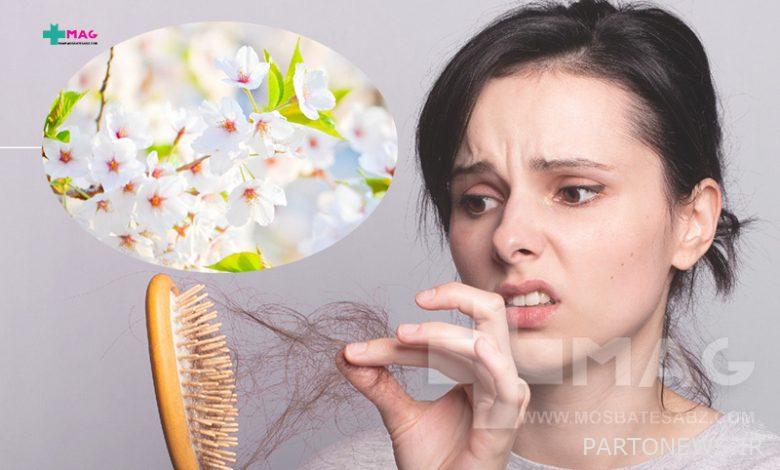Is seasonal change effective in hair loss?

Climate change can sometimes exacerbate hair loss. Normally, 50 to 100 strands of human hair are shed and replaced every day. With the change of seasons, you may sometimes find that your hair loss has become too normal. Why is this happening? In which seasons of the year are we most likely to experience seasonal hair loss? Can We Eliminate Seasonal Hair Loss By Taking Hair Strengthening Pills? Hair loss with the change of seasons is a topic that we will address in this article.
What we read in this article
Increased hair loss in spring and autumn
The most season in which people may experience seasonal hair loss is autumn. In this case, for example, if a person’s hair loss has previously been 100 per day, it will reach about 150. Our hair is in the telogen (rest) phase in summer and enters the exogenous phase (fall) in autumn. This can also happen with the change of seasons in the spring. In the spring, an increase in pollen, allergies and changes in diet may lead to hair loss. But keep in mind that hair loss is not as common in any season as autumn.
The hair growth cycle generally has 3 phases: anagen, catagen and telogen. Anagen is the stage of hair growth. In the catagen phase, the hair no longer grows and prepares to fall out and be replaced by a new hair. The telogen phase is also the phase in which hair no longer grows. Some experts also consider the exogenous phase for the hair cycle and consider hair loss to be related to this phase.
The difference between seasonal hair loss and telogen effluvium
Telogen effluvium is a type of hair loss that is caused by stress, shock and nervous disorders. The most important sign of hair loss with the change of seasons is the increase in the number of hairs that fall out during the day. After combing, you may find that your brush has more strands of hair than ever before. In season-related hair loss, hair falls sporadically from different areas of the scalp, and the reason for this is related to temperature changes. Telogen effluvium, on the other hand, occurs under stress and is sometimes found only in one area of the scalp.
Cause of hair loss in spring
According to experts, the cause of hair loss in autumn is more than anything else related to reduced sunlight and vitamin D deficiency in the body. But why is seasonal hair loss also seen in spring? Pay attention to the following factors:
Climate change and hormonal changes in the body
Simultaneously with spring, the human body undergoes hormonal changes. Hormonal changes are one of the most important causes of hair loss, especially in women. This causes the hair to fall into the hair loss phase and the person to lose more hair daily.

Increased sunlight
After passing through the two cold seasons of the year, namely autumn and winter, we enter a season in which the amount of sunlight gradually increases. One of the reasons for hair loss is related to the change of seasons due to the intense sun. If the intensity of sunlight is very high in some areas, harmful UV (ultraviolet) rays have a negative effect on hair cells and follicles and increase hair loss. If your hair is thin, you are more at risk for seasonal hair loss.
Blockage of the pores of the scalp and increased hair loss
If you live in an area that gets very hot in the spring, the reason for the increase in your hair loss at the same time as the spring may be due to the closing of the scalp pores due to excessive sweating. Obstruction of the pores of the scalp causes the hair follicles to be poorly nourished and moisturized, resulting in stunted hair growth as well as hair loss.
Related Posts
The best ways to treat hair loss by changing the season
It is interesting to know that according to statistics, seasonal hair loss is more common in women than men. Seasonal hair loss often resolves on its own without the need for any treatment. But if you are very sensitive and generally do not have thick and strong hair, you can also use the following solutions:
Eat healthy and nutritious foods
Creatine is a vital protein for hair growth. If you want to improve hair growth and the health of your hair, you must pay attention to the amount of protein in your diet. High amounts of protein will be provided to your body by eating mutton, beef, chicken and fish. You can also use eggs and vegetable proteins such as soy. Do not neglect fruits, vegetables and omega-3 fatty acids to see the least hair loss on your scalp.

Get help from hair strengthening supplements
Consumption of all micronutrients is essential for healthy hair growth. But in the meantime, some vitamins and minerals such as B vitamins (especially biotin) and zinc (zinc) play a key role. Fortunately, you can find high quality supplements in pharmacies today that have a significant effect on reducing hair loss and increasing hair growth. You can also use ampoules such as biotin and bepantin if you wish. In addition to injecting these ampoules, which are sources of B vitamins, hair strengthening pills are usually recommended. For better results, you can also use anti-hair loss solutions and lotions and choose an anti-hair loss shampoo.

Take good care of your hair
Instead of constantly tying your hair, let it loosen, as tightening your hair can be a factor in hair loss. Also try to use less hair dryers, irons and hair conditioners to do less damage to your hair. Massage your scalp every night for at least 10 minutes to increase blood circulation to help your hair grow better.
Do an annual checkup
It is true that hair loss with the change of seasons is common in many people, but not every type of hair loss can be related to this factor. It is best to have a blood test twice a year or every year to check for hormonal changes and nutrient deficiencies in your body. Do not forget that thyroid disorders are one of the most important causes of hair loss.
When does seasonal hair loss stop?
As we have described, during hair loss, the hair enters the telogen phase. It is not possible to determine exactly how long it takes for hair to re-enter the anagen phase or hair growth. But of course, when the scalp and hair adapt to the new weather conditions, the severity of hair loss will be reduced. Seasonal hair loss is temporary and you should not worry about it. However, if you have severe hair loss, other factors may be involved and you need to see a dermatologist.
Concluding remarks
Hair loss is seen with more seasonal changes in autumn, summer and sometimes spring. Climate change and the intensity of sunlight are the most important reasons for this problem. Although seasonal hair loss is not a concern, we have suggested ways to treat this complication in this article to be more successful in stopping hair loss. Have you ever experienced seasonal hair loss? Which season was your experience related to?
Please rate this article
[مجموع: ۰ میانگین: ۰]


